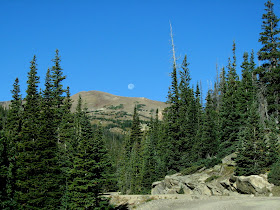While I'm sorting out my notes and photos of wildlife from my trip to Colorado, here are some landscape photos taken on Sunday in the Rocky Mountain National Park.
Upper Beaver Meadows
Driving up to the Meadows, you can't help but be impressed by the skyline on your left. This is dominated by Long's Peak (14,259 ft.).





Old Falls River Road
Most people who traveling up to the Alpine Visitor Center (11,796 ft.) drive up Trail Ridge Road, a well-surfaced modern road. However, I thought it would be more fun to head up via the Old Falls River Road, a 9-mile dirt road with innumerable hairpin bends and sections of washboard. And it was fun!




Alpine Visitor Center
There was still a little snow up near the Center.

The view was worth the drive.

Trail Ridge Road
I drove this road on the way down from the Alpine Visitor Center.





Horseshoe Park
This was the only section of the park where large numbers of aspen trees were really starting to change color.


Moraine Park
I was going to bird the campground here but it was absolutely crowded with people, cars and RVs. So instead I had a pleasant walk along the river bank.



The river was fairly slow-running and peaceful when I was there but obviously this isn't always the case.


P.S.
I entered the park at 6:45 a.m. and there weren't many other visitors around for the first couple of hours. However, by mid-morning it was much busier and it was already difficult to find a parking place at any of the major trailheads and viewing areas.
When I left, at around 1:00 p.m., the line of cars waiting to enter the park stretched several hundred yards. And this was in late September! (Although admittedly during a spell of glorious fall weather.) I imagine that most areas of the park must be quite unpleasantly crowded during the summer months.
.




























